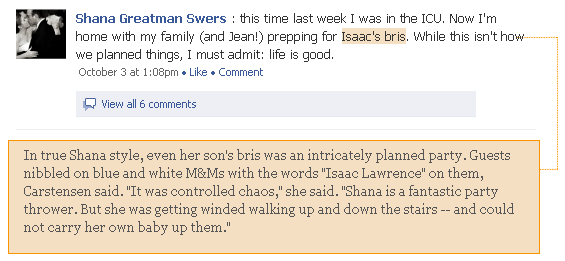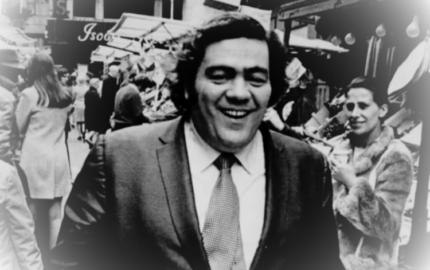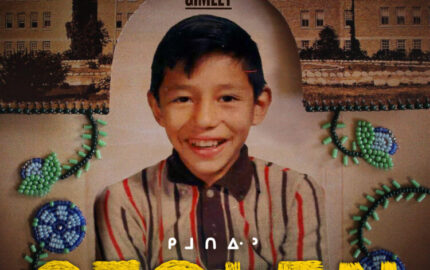Here's a glimpse of what the story looks like online:

I spoke with the story’s editor, Marc Fisher, this morning about the project. Here are excerpts from our conversation:
Where did this story come from? How did you first find out about it?
The reporter for the story, Ian Shapira, heard about it through his wife, who heard about it through her work.
What did you use to put the story together? Was it an existing tool, or something the Post’s developers put together?
We actually had to develop something expressly for this, so it took an enormous number of work hours on the part of both the designer for the web and the print designer as well. So neither was done with any template, really. Both had to experiment to get the Facebook look down right.
The challenge with print was to make it legible. That went through several iterations. And the challenge online was to make it look plausible and recognizable. We struggled with how much in the way of links to have in there. We couldn’t pick up the entire Facebook page as is, so we had to recreate the links on that page.
It’s a story told via a Facebook feed. Does that feel fundamentally different than the long-form narrative the Post has done so often and so well in the past, or is it just a question of presentation?
It is fundamentally different, because the narration is provided by the original source. We had a little bit of a struggle early on in the project about just how much of our voice would be in the story. I was pushing all the way through for us to be very much on the sidelines and providing just the necessary bits of context, so that people understood who these characters were.
One of the gifts that Shana left behind was this extraordinary narration that she provided in great detail. This is the blessing and the curse of Facebook in that people are narrating their lives in this very intimate and granular sort of way, which creeps out some people and is literally fascinating to many others. That really was one of the main reasons we did the piece.
It was a way to get people talking about how people are portraying their lives on Facebook. The story in and of itself has a power, and there’s almost a voyeuristic appeal to it. But I think what makes it worthwhile beyond that is the questions it raises about just how much we’re living on Facebook and whether and to what extent that displaces human contact.
Did you at any point consider doing the story straight and just quoting some sections of the Facebook feed?
My thought from the beginning was that we would do it in the form of a Facebook page. The reporter wanted originally to do it as more of a traditional narrative, and then he very much embraced this idea. There was definitely debate about it in the early stages, all with an eye toward how to tell the story best and how to push the envelope on using Facebook as a storytelling tool.
It’s a story about a death. Social media has a reputation for being light and entertainment-focused. Did you worry about bridging those two ideas, or were you hoping that any tension between them would heighten the impact of what is ultimately a heavy story?
It is a heavy story, but it isn’t so much a story about death as it is love and loss. It’s a tough story, and we’re hearing from a lot of people that it hits them hard. We debated over quite some time whether to leave the death as a surprise in the narrative or to give it away at the very top, and we decided to let the story take its natural course, the way it had in real life, that that was truer to the story.
There is an inherent power to this story, but I think what was equally appealing to us was the chance to talk about what Facebook means and to use this as a vehicle for getting people to think about what kinds of stories we tell on Facebook.
There are real issues about what happens when someone dies on Facebook and who owns the page and how long it stays up. There are lots of users who believe that the page belongs to the person’s friends and should stay there as a memorial, and there are relatives who in a number of cases are fighting with Facebook to get control of someone’s page or to take it down. These are real issues about who owns someone’s story. That came up in the construction of this piece.
We decided we would not do the story unless the family endorsed our doing it in this way. They were totally on board and supportive, but they might not have been.
I was just predicting last week to our sister site, Nieman Lab, that we’d be seeing a lot more stories built out of Twitter and Facebook feeds in 2011, and here you didn’t even wait for January. I was also hypothesizing that these new forms of storytelling might be clumsy for a while. Did anything about the process or the end product feel messy or awkward to you?
It’s a little different, because the restrictions of the form made it more difficult. You can’t go in and edit or change the basic text of the story, because it’s her words, and we didn’t feel we had the right to play with that the way we would with our own copy. The version that’s in the print paper is heavily condensed, but we didn’t change anything that she wrote. The version online is much more full, though it, too, is shorter than the original. It is a more difficult and more time-consuming form to work in, because what we can bring to the story really had to be super-condensed into these little annotations we included between her status updates.
It’s a restrictive form, but if you have the right kind of story – and it has to be a narrative; it has to be something that is very tightly told. Not every story lends itself to this, but I think there are these human dramas and revealing tales that take place on Facebook, and we should be exploring ways to use them to tell them in a compelling way online.
Telling it in print is probably not going to be an everyday kind of thing because of the space considerations. But as an online storytelling tool, I think it has tremendous power and promise.
What else should we know about the project?
For people trying to do this at home, it really was remarkably time-consuming, and the designers – Grace Koerber on the online side and Greg Manifold on the print side – put in lots of long nights trying to make this work. There is no template for this. The upside is that no one can steal our copy on this because it doesn’t transfer, so they’re actually going to have to link to us. But the downside is that it was many dozens of hours of work.


